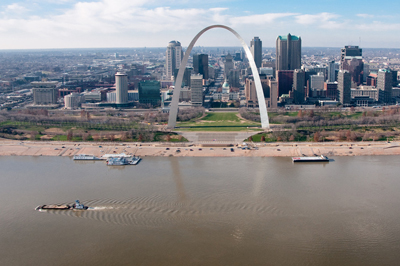The Midwest sure could use some more rain. But what the region lacks in precipitation, it makes up for in news stories about the drought. One that hits close to home is the recent Marketplace piece on the extended dry spell’s toll on river transport cities, like St. Louis.
The story featured comments from Don Sweeney, an expert on the economics of water transportation and associate director of the Center for Transportation Studies at the University of Missouri–St. Louis. He said cargo on river barges makes its way into plenty of industries, but is only a small slice of a much larger pie.
“(It’s) roughly a $7 billion to $10 billion industry nationwide,” Sweeney told Marketplace. “And in a $14 trillion economy, that’s not a big deal. But it is a big deal in the sense that it moves some of the more basic products across the nation.”
UMSL Daily caught up with Sweeney recently to get more of his thoughts on what the drought means for river shipping.
Can you put in context the drought’s impact on shipping via the Mississippi River?
The drought conditions are variable depending on exactly where you are in the river basin. For example, north of St. Louis on the Mississippi River navigation conditions and operations are near normal with no real shipping restrictions. Below St. Louis, there are areas of the river where tow sizes (the number of barges that can be pushed by a single towboat) and barge drafts (how deep each barge can be loaded) are significantly restricted to less than normal operating levels. Right, now, the restrictions on tow sizes and barge loadings relative to normal operations generally get tighter as you move south on the Mississippi River (near Memphis, Tenn., Vicksburg, Miss., Baton Rouge, La., etc.). The restrictions increase shipping costs as each barge and towboat is made less productive than it normally would be while incurring essentially the same operating costs to move less cargo per tow.
Will this have any effect on the prices for consumers?
Prices on goods for consumers may increase slightly due to increased barge transportation costs during a drought. Generally shipping costs are a relatively small component of delivered prices of goods moved on the Mississippi River. For a prolonged drought, price effects felt by consumers could become significant depending on the goods in question and the duration of the drought.
Are substitutes for barge shipping used in times of drought?
Alternative modes of transportation, to the extent they are available, are used to meet shipping needs that barge shipping can’t meet in times of drought. Also, other mitigating strategies such as moving products to and from different markets may be utilized if available. If the drought is anticipated, inventories built by advanced shipping of products may be used to buffer the drought’s effects.















